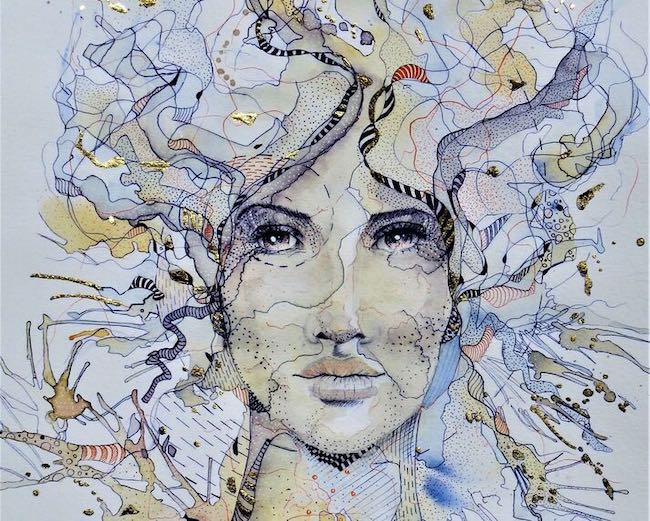La femminilità, intesa come essenza più eterea e pura, ha cercato di essere esplorata da molti artisti che si sono spinti a spiegarne il mistero insito nella sua natura accogliente e al tempo stesso respingente, dolce e al contempo forte, remissiva ma determinata, come se costituisse uno scoglio irraggiungibile ma anche un faro di luce in grado di ammaliare la sensibilità ammirata degli autori che l’hanno immortalata. Nel momento in cui però sono state le artiste donne a concentrarsi sulla riproduzione della figura femminile ne hanno dato un’interpretazione differente, sicuramente meno poetica ma più realista, più impegnata a mostrarne una concretezza che all’uomo, concentrato sulle sensazioni della contemplazione, sfuggiva. La capacità empatica di una personalità femminile verso un’altra donna, o tante altre donne, ha permesso alle pittrici di osservare e mettere in evidenza aspetti nuovi, punti di vista sfaccettati, poliedrici, in cui al centro non era più l’enigma irraggiungibile perché incomprensibile alla natura maschile bensì il ventaglio di sensazioni e di emozioni percepite e poi manifestate con l’abituale apertura e trasparenza che appartengono al femmineo. La protagonista di oggi concentra la sua produzione artistica sulla donna ma anche sul legame con la natura che diviene base sostanziale della sua pittura.
Nel momento in cui un celeberrimo maestro come Botticelli dipinse la sua meravigliosa opera La nascita di Venere diede di fatto inizio a una stretta interrelazione tra la bellezza femminile e la natura che circonda la donna proprio in virtù della sua attitudine alla sensibilità, al porsi come collegamento tra la durezza maschile e quell’energia quasi magica che avvolge l’essere umano e che solo il delicato animo femminile è in grado di intuire. Nel caso di Botticelli la donna era rappresentata come una divinità con tratti umani ma con un’essenza inarrivabile, come a volerne sottolineare l’intoccabile purezza. Molti secoli dopo, intorno agli ultimi decenni del Novecento vi furono due movimenti pittorici che ricominciarono a mettere in risalto la donna in relazione con la natura e la libertà e leggerezza che proprio da quella vicinanza derivano; l’Impressionismo di Joaquin Sorolla lasciò scorci poetici e romantici di spiagge, di pomeriggi di svago trascorsi al mare a contrastare la forza della brezza, di cui in prevalenza era protagonista proprio la figura femminile, come se l’artista volesse imprimere su ogni tela la sua totale ammirazione per un universo interiore tanto delicato. E poi l’Art Nouveau di cui le linee guida erano proprio la centralità della natura, in particolare dei fiori e degli alberi, e della donna che della poesia degli elementi di flora e fauna era perfetta interprete; nel caso di questo movimento dunque non contava più il paesaggio in cui collocare i soggetti protagonisti bensì al contrario tutto ciò che era importante era l’armonia sinuosa degli steli e dei rami che dovevano avvolgere i corpi femminili che divenivano dunque solo co-protagonisti dei dipinti. Nella sua declinazione austriaca, quella del Secessionismo Viennese di Gustav Klimt, il movimento vide l’introduzione della foglia oro come sontuoso elemento decorativo che andava ad amalgamarsi alla ricerca di naturalità di quell’epoca elegante, raffinata e orientata al bel vivere che precedette il periodo buio delle guerre mondiali. L’artista croata Sabina Čanić, donna e pertanto in grado di percepire in modo più profondo il legame tra la propria sensibilità e il mondo naturale, non solo in qualche modo si ricongiunge all’Art Nouveau per la delicatezza con cui avvolge le sue protagoniste sempre circondate di fiori immaginari e di foglie indefinite sottolineate con tocchi di foglia oro, ma di fatto la reinterpreta utilizzando i frattali della Computer Art per andare a comporre la morbidezza della natura che solo da vicino si scopre essere in realtà un tratto grafico indefinito ma sinuoso e armonioso.
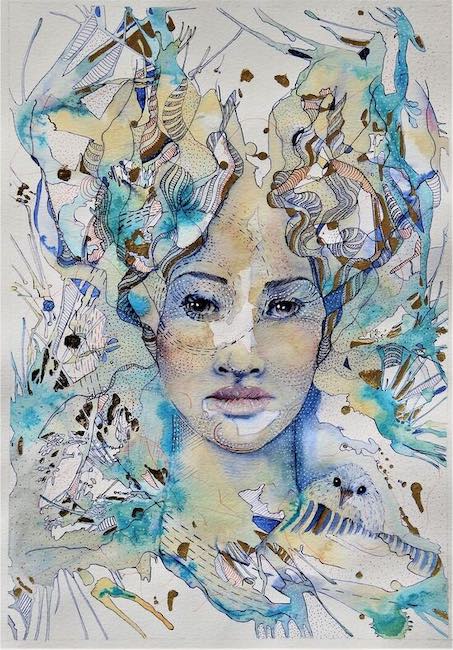
Ma Sabina Čanić va ancora più oltre, proprio per concretizzare quella forte e intensa connessione con tutti gli elementi vitali che fanno parte della quotidianità dell’esistenza e che mai si penserebbe possano sostituirsi ai colori tradizionali o alle tecniche cromatiche più classiche, sperimentando un modo nuovo di dipingere in cui associa il suo amore per il disegno a tecniche innovative che le consentono di non perdere mai il contatto con la sua amata natura.
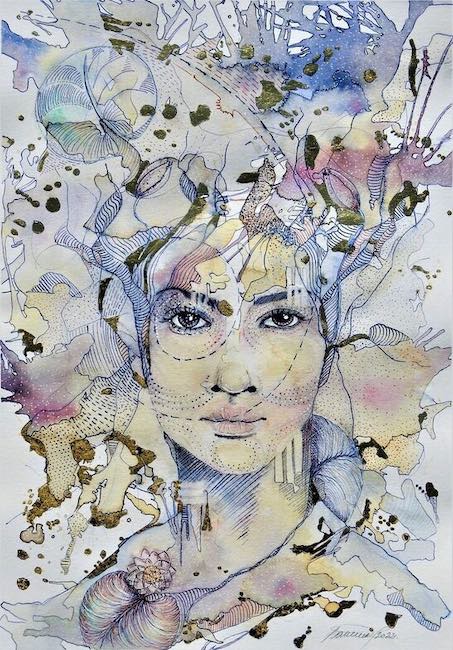
Ecco perché in qualche modo la Čanić esalta e addirittura amplia le tematiche dell’Art Nouveau, la sua arte si amalgama letteralmente e in alcuni casi sfrutta addirittura fenomeni atmosferici come la pioggia per andare ad agire direttamente sull’opera ottenendo sfumature spontanee che ammorbidiscono il tratto dell’inchiostro, della grafite e dei pennarelli così come inconsueto è l’utilizzo del vino rosso e del the da cui ottiene alcune tonalità derivanti naturalmente da queste sostanze.
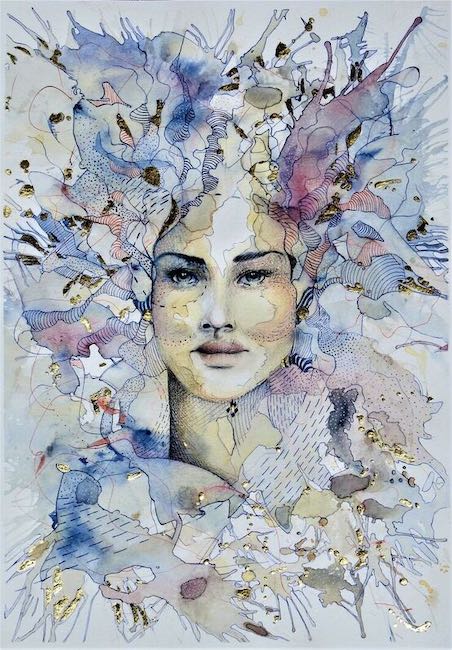
I suoi dipinti sono stratificati, presentano sette diversi livelli, sette materiali differenti e con variegate tecniche come quella dell’asciugatura alle basse temperature invernali in modo che le parti bagnate della vernice si congelino e si trasformino in frattali; il sette è il numero della perfezione, della completezza e probabilmente è in questo che riveste un’importanza particolare per Sabina Čanić, perché lei sa che c’è bisogno di approfondimento e di empatia per essere in grado di andare a scavare nell’anima e nelle personalità delle donne che divengono protagoniste delle sue opere.
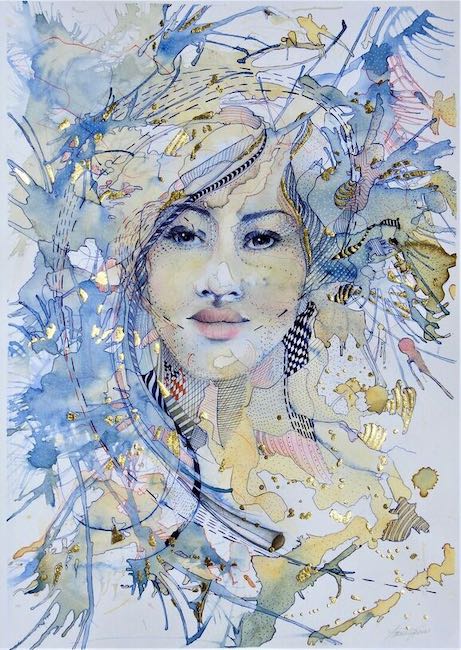
Parimenti a quanto accadeva nell’Art Nouveau di fine Ottocento, la figura umana viene riprodotta con una notevole fedeltà a quanto osservato, sebbene la gamma cromatica scelta dall’artista per descrivere la pelle sia irreale, tenue perché composta dai frattali che tanto appartengono al suo tratto grafico, così come una delle costanti è la presenza intorno a uno degli occhi delle donne di queste opere della spirale di Fibonacci, a sottolineare quanto, malgrado l’apparenza, la scienza e la matematica possano connettersi con la poesia di un’immagine o della natura. Dunque la Čanić inganna lo sguardo dell’osservatore, attrae e cattura con una rappresentazione effimera che poi si modifica man mano che ci si avvicina all’opera, sottintendendo quanto in fondo tutto sia governato da un ordine matematico, scientifico, superiore, di cui spesso l’essere umano è inconsapevole. E così le donne che descrive vivono le proprie emozioni, le sensazioni in maniera spontanea, inconscia, come se Sabina Čanić avesse la capacità di scoprirne i dettagli, gli impercettibili frammenti di pensieri che attraversano la loro mente e che vanno a delineare non solo la loro personalità ma anche a descrivere l’istante vissuto nel momento in cui sono state immortalate.
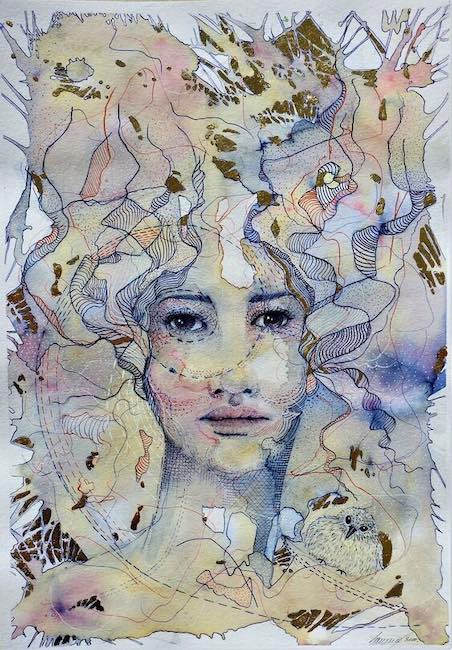
Blue rain è stata la prima opera in cui l’artista ha letteralmente permesso alla natura di agire direttamente sul disegno, facendola diventare così una vera a propria collaboratrice nell’esecuzione del risultato finale poiché in una delle sette immancabili fasi del suo processo di realizzazione ha lasciato che delle gocce di pioggia cadessero delicatamente sul disegno andando a sfumare alcune parti realizzate con l’inchiostro blu, ecco il motivo della scelta del titolo, dissolvendole e lasciando al loro posto una delicata traccia azzurra ad ammorbidire l’aspetto finale. Sembra malinconica l’espressione della donna in accordo con l’atmosfera autunnale che sembra avvolgerla.
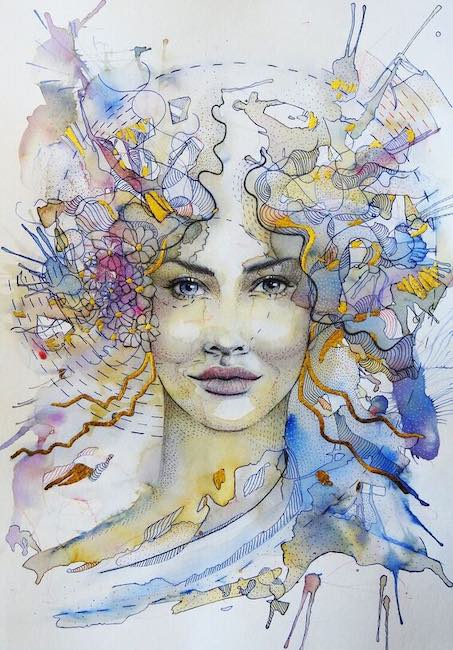
In Flora invece la ragazza immortalata dalla Čanić è solare, fiera, come se stesse affrontando un risveglio, come se avesse raggiunto una consapevolezza di sé che non potrà mai più essere messa in discussione, e dunque anche la natura intorno ha i toni vivaci e solari dell’anima, del benessere, dell’armonia tra interno ed esterno che va a illuminare tutto ciò che la circonda. La spirale di Fibonacci è particolarmente presente in quest’opera, si espande verso l’esterno e circonda il capo a sottolineare quanto la sua determinazione e l’equilibrio raggiunto siano parte di un percorso di consapevolezza ma anche di osservazione delle energie circostanti, in un continuo alternarsi di alti e bassi che le hanno insegnato a prendere il meglio dagli accadimenti e a trovare la chiave di lettura positiva anche negli eventi più complessi, divenendo così via via più forte. Tante le sfaccettature quante le personalità differenti che vanno a costituire il variegato puzzle della femminilità, spesso tendente a rinunciare a se stessa nascondendosi, fino al momento in cui invece sceglie di prendere in mano la propria vita e ricominciare da un nuovo punto per andare verso un livello superiore, più affine alla vera inclinazione e attitudine alla vita, come espresso nell’opera Explosion of life.
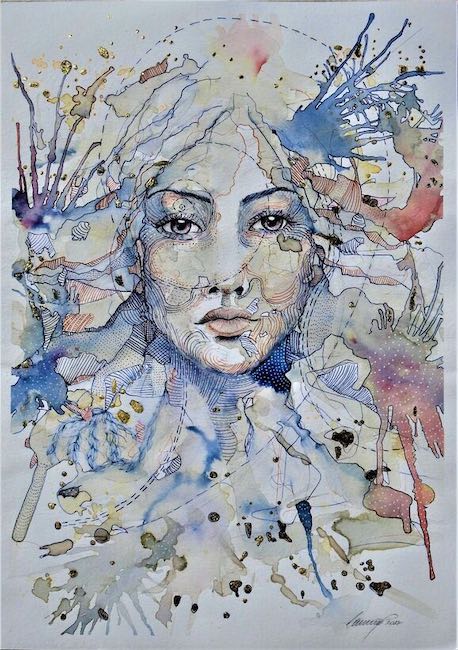
Sabina Čanić ha al suo attivo la partecipazione a numerose mostre in Croazia e all’estero – Italia, Serbia, Bosnia-Herzegovina, Regno Unito, Corea – riscuotendo grande interesse da parte dal pubblico e dagli addetti ai lavori.
SABINA ČANIĆ-CONTATTI
Email: sabina.canic.art@gmail.com
Sito web: https://www.artworkarchive.com/profile/sabina-canic
Facebook: https://www.facebook.com/sabina.canic.art
Instagram: https://www.instagram.com/sabinacanicart
Linkedin: https://www.linkedin.com/in/sabinacanic
Sabina Čanić’s Symbolist Art Nouveau to narrate the connection with natural elements through the representation of different shades of women
Femininity, understood as the most ethereal and purest essence, has sought to be explored by many artists who have gone out of their way to explain the mystery inherent in its welcoming yet repelling nature, gentle yet strong, submissive yet determined, as if it constituted an unattainable rock but also a beacon of light capable of bewitching the admiring sensibilities of the authors who immortalized it. The moment, however, that it was female artists who focused on the reproduction of the female figure, they gave a different interpretation of it, certainly less poetic but more realistic, more committed to showing a concreteness that eluded the man, focused on the sensations of contemplation. The empathic capacity of a female personality toward another woman, or many other women, allowed women painters to observe and highlight new aspects, multifaceted, polihedral points of view, in which at the center was no longer the unattainable enigma because incomprehensible to masculine nature but rather the range of sensations and emotions perceived and then manifested with the usual openness and transparency that belong to the feminine. Today’s protagonist focuses her artistic production on women but also on the connection with nature that becomes the substantial basis of her painting.
At the moment when a celebrated master such as Botticelli painted his marvelous artwork The Birth of Venus he actually initiated a close interrelationship between feminine beauty and the nature surrounding woman precisely because of her aptitude for sensitivity, for standing as a link between masculine toughness and that almost magical energy that envelops the human being and that only the delicate feminine soul is able to intuit. In Botticelli‘s case, woman was depicted as a divinity with human features but with an unmatched essence, as if to emphasize her untouchable purity. Many centuries later, around the last decades of the twentieth century, there were two pictorial movements that began again to emphasize woman in relation to nature and the freedom and lightness that come from that very closeness; the Impressionism of Joaquin Sorolla left poetic and romantic glimpses of beaches, of leisurely afternoons spent at the seaside counteracting the force of the breeze, of which the female figure itself was predominantly the protagonist, as if the artist wanted to imprint on each canvas his total admiration for such a delicate inner universe. And then the Art Nouveau whose guidelines were precisely the centrality of nature, in particular of flowers and trees, and of the woman who was the perfect interpreter of the poetry of the elements of flora and fauna; in the case of this movement, therefore, the landscape in which to place the protagonist subjects no longer mattered but, on the contrary, all that was important was the sinuous harmony of the stems and branches that were to envelop the female bodies that thus became only co-protagonists of the paintings. In its Austrian declination, that of Gustav Klimt‘s Viennese Secession, the movement saw the introduction of gold leaf as a sumptuous decorative element that went with the quest for naturalness of that elegant, refined, and good-living-oriented era that preceded the dark period of the World Wars. The Croatian artist Sabina Čanić, a woman and therefore able to perceive in a deeper way the connection between her own sensibility and the natural world, not only somehow reconnects with Art Nouveau because of the delicacy with which she wraps her protagonists always surrounded by imaginary flowers and undefined leaves emphasized with touches of gold leaf, but in fact reinterprets it by using Computer Art fractals to go and compose the softness of nature that only up close turns out to be actually an indefinite but sinuous and harmonious graphic line.
But Sabina Čanić goes even further, precisely in order to concretize that strong and intense connection with all the vital elements that are part of the everydayness of existence and that one would never think could replace traditional colors or more classical color techniques, experimenting with a new way of painting in which she associates her love of drawing with innovative techniques that allow her to never lose touch with her beloved nature. That is why in some ways Čanić enhances and even expands the themes of Art Nouveau, her art literally amalgamates and in some cases she even exploits atmospheric phenomena such as rain to go and act directly on the artwork obtaining spontaneous nuances that soften the strokes of ink, graphite and markers just as unusual is the use of red wine and tea from which she obtains some enriched tones deriving naturally from these substances. Her paintings are layered, they present seven different layers, seven different materials and with varied techniques such as drying at low winter temperatures so that the wet parts of the paint freez and turn into fractals; seven is the number of perfection, of completeness and it is probably in this that it holds special importance for Sabina Čanić, because she knows that there is a need for depth and empathy in order to be able to go and delve into the souls and personalities of the women who become the protagonists of her works. Similar to the Art Nouveau of the late nineteenth century, the human figure is reproduced with remarkable fidelity to what is observed, although the color palette chosen by the artist to depict the skin is unreal, tenuous because it is composed of the fractals that so much belong to her graphic line, just as one of the constants is the presence around one of the eyes of the women in these artworks of the Fibonacci spiral, emphasizing how much, despite appearance, science and mathematics can connect with the poetry of an image or nature.
So Čanić deceives the viewer’s gaze, attracts and captures with an ephemeral representation that then changes as one gets closer to the work, implying how fundamentally everything is governed by a mathematical, scientific, higher order, of which human beings are often unaware. And so the women she describes experience their emotions, feelings in a spontaneous, unconscious way, as if Sabina Čanić had the ability to discover the details, the imperceptible fragments of thoughts that run through their minds and go to delineate not only their personalities but also to describe the instant experienced in the moment they were immortalized. Blue rain was the first work in which the artist literally allowed nature to act directly on the drawing, thus making it a true collaborator in the execution of the final result since in one of the seven unfailing steps of her process of making it, she let raindrops gently fall on the drawing going to blur some parts made with blue ink, hence the reason for the choice of the title, dissolving them and leaving in their place a delicate blue trace to soften the final appearance. The woman’s expression seems wistful in keeping with the autumnal atmosphere that seems to envelop her. In Flora, on the other hand, the girl immortalized by Čanić is sunny, proud, as if she were facing an awakening, as if she had attained a self-awareness that can never again be questioned, and therefore the nature around her also has the bright, sunny tones of the soul, of well-being, of the harmony between inside and outside that goes to illuminate everything around her. The Fibonacci spiral is particularly present in this artwork, expanding outward and encircling the woman’s head to emphasize how much her determination and the balance she has achieved are part of a path of awareness but also of observation of the surrounding energies, in a continuous alternation of ups and downs that taught her to take the best from happenings and find the positive key even in the most complex events, thus gradually becoming stronger. As many facets as different personalities that go to make up the varied puzzle of femininity, often tending to renounce herself by hiding, until the moment when she instead chooses to take charge of her life and start again from a new point to move towards a higher level, more akin to the true inclination and attitude to life, as expressed in the artwork Explosion of life. Sabina Čanić has to her credit the participation in numerous exhibitions in Croatia and abroad – Italy, Serbia, Bosnia-Herzegovina, the United Kingdom, Korea – garnering great interest from the public and insiders.


